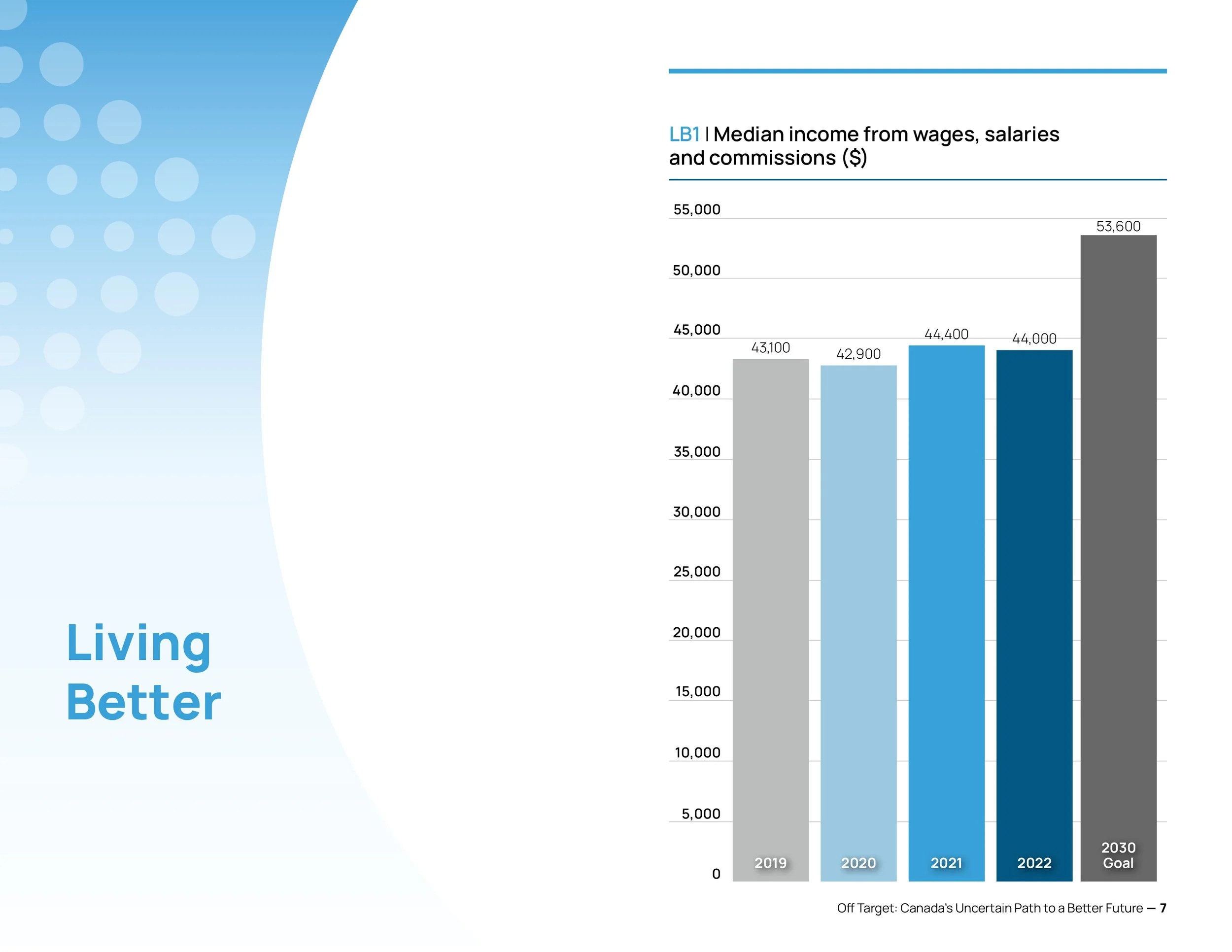
Living Better
Direction: Retreating
Risk: High
Pace: Lagging
This pillar is about drivers that boost living standards.
The aim is to promote policies and practices that will lead to better lives for all of us.
To gauge progress on this front, we monitor eight indicators—from how quickly incomes are growing to the share of women in senior management positions.
The results show not only that we remain far from our targets, but that our progress is stalled and in some cases deteriorating.
Growth at a glance
Aspirational targets have been set across the three pillars to attain long term, inclusive and sustainable growth.
Prosperity Index Ranking (#)
Canada stepped up one place in 2023 and now stands in 13th place in the Prosperity Index Ranking.
Prosperity is much more than money or wealth, it is about growth, opportunity, freedom and responsibility. History reveals the foundations of prosperity which are the beliefs, values, culture and traditions that create virtuous people, trust-based societies and strong nations. By understanding what has worked before, we can thoughtfully apply ancient wisdom to modern challenges, translating sound principles into better institutions and policies.
Source: Legatum Institute
Living Standards
Median income from wages, salaries and commissions ($)
Canadian median wages have decreased from 2021.
We need to have a 2.5% annual growth rate to meet the goal.
According to Statistics Canada’s latest income survey, the median after-tax incomes of Canadian households fell by 3.4 per cent in 2022, and the poverty rate jumped by 2.5 percentage points to 9.9 per cent.
Average poverty gap (%)
Both the average poverty gap and the percentage of people in low income increased in 2022.
Higher borrowing costs and consumer prices have caused poverty rates to rise and real incomes to fall. Young families and low-income earners, in particular, have been hit hard by the increases in both the cost of living and the cost of credit.
Income parity across genders, races, people with disabilities (%)
The earnings gap varies by racialized group. Racialized Canadians earn 80 cents for every dollar that non-racialized Canadians earn.
The labour market picture for racialized Canadians and immigrants continues to be worrying as the economy softens. The unemployment rate for visible minorities jumped to 8.4 per cent at the end of 2024, up from 7.1 per cent at the end of last year and more than three percentage points above the jobless rate for non-visible minorities.
Human Capital
Participation in adult learning (%)
Canada lags peer countries in “participation in adult learning” in 2019.
Note: Participation in adult learning extracted from “Survey of Adult Skills (PIAAC)” has not been updated since 2019.
Share of Indigenous population in senior management positions (%)
Since 2017, women have consistently held a share in legislative and senior management positions that is approximately 2 to 2.5 times smaller than that of men.
The picture for women is mixed. According to Statistics Canada’s labour force survey data,
the share of women in all management jobs rose slightly in 2024, hitting 36.4 per cent, a record high. But we need to see faster progress. That number has been essentially stuck at about 35 per cent over the past two decades. When looking at the most senior management roles in all sectors including government, women held 28.9 per cent of those positions, down from 30.1 in 2023. The share of women in these top positions has averaged 31.1 per cent over the past decade. Statistics Canada lacks data on how women are doing in the C-suites of corporate Canada.
Share of women in senior management positions (%)
Canada showed a fluctuating gap in the labour participation rate between Indigenous and non-Indigenous between 2021-2023.
Canada’s recent gains around economic inclusivity have plateaued or reversed in certain instances. For example, last year saw a deterioration in labour market outcomes for Indigenous Peoples, who recorded declines in both employment and participation rates. This was a reversal of gains made in recent years. In 2022, the participation rate for the Indigenous population had even surpassed the non-Indigenous rate for the first time ever. But the gap re-emerged in 2023 and widened again last year. In 2023, the share of management positions
held by First Nations, Inuit and Métis inched higher to 2.5 per cent, from 2.4 per cent a year earlier. This is still less than half the Coalition’s five-per-cent aspirational target for management positions.
Share of youth not in education, employment, or training (%)
Canada has witnessed a slight increase from 11.6% in 2022 to 11.7% in 2023.
Among G7 countries, only Germany and the U.S. have a lower share of youth NEET than Canada.




